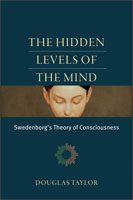At some point in college, I got fed up with theological charts and diagrams. Attending religion classes at the Academy of the New Church high school and Bryn Athyn College of the New Church, I saw plenty of them. There were a few reasons I got fed up with them, but mostly it had to do with me: I realized that in thinking I could understand spirituality with charts and diagrams, I had been mistaking the map for the territory.
The Hidden Levels of the Mind by Douglas Taylor – featured this month at the Patheos Book Club – has lots of theological diagrams of the mind. And yet, I didn’t hate it. In fact, I loved it. The thing is, even if they oversimplify things, diagrams of spiritual concepts help provide a framework that you can hang things on. Even as you come across things that don’t seem to quite fit into the neat boxes in the diagram, without that framework you don’t have much of a picture at all. And in The Hidden Levels of the Mind, Taylor does an excellent job of presenting that framework of the structure of the human mind according to the theological writings of Emanuel Swedenborg.
If you’re planning to read Swedenborg – and especially if you’re planning to read something in Swedenborg without reading a whole work – I’d recommend checking out this book first. It explains the basic New Church concept of the mind as it exists in its different levels – celestial, spiritual, and natural – and in its two sides, the will and the intellect. If you’re looking for a clear, concise explanation of how Swedenborg views the mind, this is it.
This might also be the book for you if you’re simply curious about a different way to envision the structure of the mind. This particular way of looking at it makes a lot of sense based on the way I experience reality (although of course this is colored to some extent by my having been raised in the New Church). The book relies on primarily on that – on the reader’s own experience – to confirm the view of the mind presented there. It doesn’t provide much in the way of scriptural confirmation, and so it is unlikely to convince those who are looking for the Biblical basis for these teachings, although there are some scriptural references (another book by Taylor, The Scriptural Basis of New Church Teachings, does provide a lot of scriptural passages, but is sadly out of print). But this is a deeply religious book – it’s also not for those looking for the most up-to-date scientific evidence of the way the mind works. The heart of the book is an examination of the way the mind develops when a person is living by Scripture and looking to God.
I appreciate that the book addresses the progression of the mind, not just looking at it as a static thing. The book’s greatest strength is in its description of the way that a person’s natural mind can be reborn from the spiritual. Taylor describes the Swedenborgian concepts of the higher levels of the mind – the celestial, where love to the Lord dwells, and the spiritual, where there is love towards the neighbour – but he focuses on the lower level, the natural level of the mind, and he focuses on the way a person’s consciousness develops on that level. The natural level itself is described as being divided into three levels: the sensory, the middle natural (knowledge, generalizations), and the rational. As a person grows up as a child, he develops from the sensory to the middle natural to the rational. When he reaches adulthood, on the rational level he can choose to follow God; and from that rational decision, he can change the way he looks at things and the way he uses what he knows; until finally, eventually, even on the sensory level he enjoys doing good things and actively dislikes doing evil.
It would be easy to present these ideas in a dry, boring way; thankfully, this isn’t the case here. The book is much more than a series of diagrams or technical explanations. The tone of the book is warm and conversational. Taylor provides simple, everyday examples illustrating the concepts he’s describing. A typical example, illustrating the way that our different perspectives affect the way we see things:
A geologist, an artist, and a farmer might look at the same rocky mountain, but their eyes would see three different mountains. The geologist would be thrilled with the examples of the Mesozoic rocks and the (obvious for him) history of their formation; the artist would be very moved by the colors and the grandeur of the magnificent silhouette; the farmer might grumble, “You couldn’t grow any crops up there!” (p. 29)
It’s simple examples like this that make this book so readable. In my senior year of high school, I took a class in calculus, and was surprised at how simple and straightforward calculus was. It wasn’t until a few years later that I realized that the only reason it had seemed that way was that it had been taught by an expert teacher, who knew how to present complex information in a way that just made sense. That’s the same sense I get from this book: I’m being taught by a master teacher, who has learned over many years to present deep, complex ideas in simple, straightforward language. This is spirituality that makes sense – which is in fact the title of another of Taylor’s books. Even with the Swedenborgian concept of the mind already deeply ingrained in me – I don’t know if I could look at the world any other way – this book re-inspired me with the beauty and simplicity of the teachings on the way the mind can be reborn.
Of course, these are still deep concepts, and they still contain complex ideas. A short book like this, and all the charts in the world, can only get you so far. Taylor closes the book with an acknowledgment of this fact:
We need to refer these teachings to our own mind and examine our own thoughts, feelings, and motives before we can put any of this information to use in spiritual development. Diagrams or charts may very well be useful to give us a fundamental view of the subject, but we do not have a realistic view of our mind until we realize, for example, that regardless of our present character, there are also higher levels to our mind that are hidden from everyday consciousness. Deep within ourselves we have something heavenly from the Lord. That is our potential. There are no exceptions to that. (p. 90)
The book is only a beginning, providing “a very general presentation of Swedenborg’s concept of the mind, clarifying it and providing a structured framework upon which to hang his other teachings” (Preface, p.xii). As far as I know, it’s the only book of its kind that sets out to do that, and it succeeds brilliantly.












